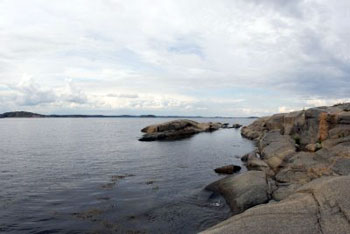 My mother phoned from Tjøme, the little island in the Oslo fjord that she calls home every June and July. She told me that the house was not too dusty, that the garden was overgrown but that a nice man was coming over to cut the lawn and trim the hedge so that she could see the ocean over it from her breakfast table. Of course, no-one had filled her fridge, so she had no milk, or tea, or bread, or jam. My aunt doesn't think of these things and I find it quite strange. I wonder if it is a cultural thing, or whether she doesn't think or whether she is just selfish. I wonder if my sister had made the long trip by boat and car all the way from England to spend six weeks with me on the island we grew up spending summers on since we were children, I could even imagine not greeting her with a full fridge and a vase of flowers on the table, a cup of tea, a glass of wine, a simple supper?
My mother phoned from Tjøme, the little island in the Oslo fjord that she calls home every June and July. She told me that the house was not too dusty, that the garden was overgrown but that a nice man was coming over to cut the lawn and trim the hedge so that she could see the ocean over it from her breakfast table. Of course, no-one had filled her fridge, so she had no milk, or tea, or bread, or jam. My aunt doesn't think of these things and I find it quite strange. I wonder if it is a cultural thing, or whether she doesn't think or whether she is just selfish. I wonder if my sister had made the long trip by boat and car all the way from England to spend six weeks with me on the island we grew up spending summers on since we were children, I could even imagine not greeting her with a full fridge and a vase of flowers on the table, a cup of tea, a glass of wine, a simple supper?
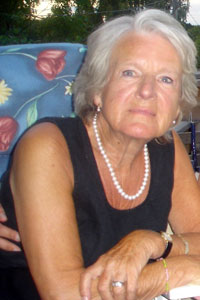 My mother can't walk very well but soldiers forth with her stick into the unknown and complains relatively little although I know she is often in pain. It is particularly cruel that someone so athletic would lose the proper use of her legs. She brings delicacies in her suitcases – food from Waitrose, eggs from the hens, wine, British tea bags – packed into her car for the long journey. More often than not she opens the house herself, unbolting all the windows so that the air can whirl around freely, makes the beds, dusts the bookshelves and the curtains, beats the cushions outside on the rock. She climbs up the granite rock to raise the flag, signifying that she is home. It is a custom to swim twice a day, whatever the weather, the temperature of the sea and the jellyfish situation. The local people pass her on the little road as she walks down the little road to the jetty for her swim. She knows everyone, smiles at everyone, says "Good Morning," asks about the fishing or the King, whose summer house is just across the bay. She is delightful but forthright. She is, after all, a Norwegian.
My mother can't walk very well but soldiers forth with her stick into the unknown and complains relatively little although I know she is often in pain. It is particularly cruel that someone so athletic would lose the proper use of her legs. She brings delicacies in her suitcases – food from Waitrose, eggs from the hens, wine, British tea bags – packed into her car for the long journey. More often than not she opens the house herself, unbolting all the windows so that the air can whirl around freely, makes the beds, dusts the bookshelves and the curtains, beats the cushions outside on the rock. She climbs up the granite rock to raise the flag, signifying that she is home. It is a custom to swim twice a day, whatever the weather, the temperature of the sea and the jellyfish situation. The local people pass her on the little road as she walks down the little road to the jetty for her swim. She knows everyone, smiles at everyone, says "Good Morning," asks about the fishing or the King, whose summer house is just across the bay. She is delightful but forthright. She is, after all, a Norwegian.
The little island seems thousands of miles and light years away from Los Angeles, our groaning Metropolis where anything can be ordered, any service found, any food item delivered. I have long been lobbying for a housekeeper for the Norwegian hut, someone who will come in to spring clean the house, make the beds, fill the rooms with flowers, put food in the fridge and so on, so that my mother doesn't have to do it herself. But as hard as we look it seems there are no Norwegians – or Eastern Europeans for that matter, as the Polish now seem to be stalwartly upholding the infrastructure of the country much as the Hispanic population does at home – willing to take on such a task. My mother won't always be able to do this. Even now it is a struggle (the latest additions of a washing machine and an inside loo have quite marvelously propelled us into the 21st Century). We are so spoiled here in this big city, with our car culture, our huge supermarkets, movies on demand, teams of cleaning ladies (if we need it), laundry services and dry cleaners, take out from every country in the world. We are spoiled and probably ungrateful.
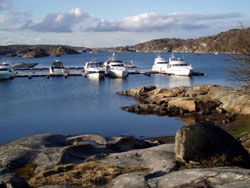 The whole family pines for the simple life on the island. The days are impossibly long, the nights short and in our memories the air is always a pleasant 70 degrees. Boats bob along in the bay. Every morning against the pink sky the old fisherman in their klinkerbuilt put-putters venture out to sea, strings of beers trawling behind them. Small boys in fat orange life vests whiz around in tiny boats with hardly enough horse power to get them across the bay. Large yachts come and go and set down anchors and send little rowboats with bicycles on board to shore to shop for the next week's provisions. Children try to pick the cherries before the hungry seagulls get to them. The same familiar faces hang out down at the dock, the blonde-haired boys that I lusted after as a teenager are now grown and rugged and sporting bad grey shoes and brown socks that only Northern or Eastern Europeans can. Girls in shorts pick daisies and lupins on the side of the road.
The whole family pines for the simple life on the island. The days are impossibly long, the nights short and in our memories the air is always a pleasant 70 degrees. Boats bob along in the bay. Every morning against the pink sky the old fisherman in their klinkerbuilt put-putters venture out to sea, strings of beers trawling behind them. Small boys in fat orange life vests whiz around in tiny boats with hardly enough horse power to get them across the bay. Large yachts come and go and set down anchors and send little rowboats with bicycles on board to shore to shop for the next week's provisions. Children try to pick the cherries before the hungry seagulls get to them. The same familiar faces hang out down at the dock, the blonde-haired boys that I lusted after as a teenager are now grown and rugged and sporting bad grey shoes and brown socks that only Northern or Eastern Europeans can. Girls in shorts pick daisies and lupins on the side of the road.
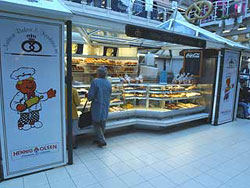 Tjøme has maybe three restaurants and one pizza place which I have not tried and does not, to my knowledge, deliver. Their specialty is, of course, Hawaiian pizza, that most traditional of all pizzas. The supermarkets (there are three) have improved over the last ten years and in the summertime when the summer folks drive in from Oslo in their Volvos and Audis, the shelves are stocked with more sophisticated fare: baby lettuces and good quality olive oil and pita bread as well as the local specialties. We've lived many summers feasting on fish from the sea, bread and pastries from the delicious Nøtterø Bakeri and fresh berries from the farm stand on the side of the road by Vrengen Bro which connects Tjøme to Nøtterø and Tønsberg. We go to Ormlet for the fish market, and to the farm for our vegetables. Life is far more simple with great chunks of it spent lying on warm grey rocks staring at an impeccably blue sky.
Tjøme has maybe three restaurants and one pizza place which I have not tried and does not, to my knowledge, deliver. Their specialty is, of course, Hawaiian pizza, that most traditional of all pizzas. The supermarkets (there are three) have improved over the last ten years and in the summertime when the summer folks drive in from Oslo in their Volvos and Audis, the shelves are stocked with more sophisticated fare: baby lettuces and good quality olive oil and pita bread as well as the local specialties. We've lived many summers feasting on fish from the sea, bread and pastries from the delicious Nøtterø Bakeri and fresh berries from the farm stand on the side of the road by Vrengen Bro which connects Tjøme to Nøtterø and Tønsberg. We go to Ormlet for the fish market, and to the farm for our vegetables. Life is far more simple with great chunks of it spent lying on warm grey rocks staring at an impeccably blue sky.
My mother has been coming here since she was a little girl. During the war they rented a house on the other side of the island and due to the travel restrictions imposed by the Nazis, my grandfather and his friends would have to swim across the channel between Tjøme and Nøtterø. With their wives and children safely situated on the island for the summer, the husbands would drive down from Oslo where they worked on Friday night, park their cars, strip off and swim the quarter mile across the channel at midnight when they thought no-one could see them. Bags of fresh clothes would be waiting for them on the other side, along with very happy wives. There's a very tiny window of darkness in Norway during the summer nights, and usually an hour was all they had, with the sun setting at about 10 and coming up at 2.
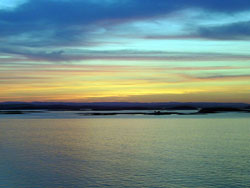 Later on, in the 40s, once they had moved to Oslo from Tønsberg, my grandparents bought the house that is now my aunt's, overlooking the Grimestad bay, with Engø to the right, Magerø to the left and the flotilla of skerry islands barely shielding the Fredrikstad coastline straight ahead (and three or four hours away by boat). Our house (or hut) is just down the hill from it, closer to the sea. It was built as a surprise for my mother by her parents in about 1969. I'm not sure if it was a surprise only for us, the children, but I remember the shock and excitement of driving up the little dirt road in my Bestefar's old Lancia Flavia and seeing the pretty little cottage that hadn't been there the year before.
Later on, in the 40s, once they had moved to Oslo from Tønsberg, my grandparents bought the house that is now my aunt's, overlooking the Grimestad bay, with Engø to the right, Magerø to the left and the flotilla of skerry islands barely shielding the Fredrikstad coastline straight ahead (and three or four hours away by boat). Our house (or hut) is just down the hill from it, closer to the sea. It was built as a surprise for my mother by her parents in about 1969. I'm not sure if it was a surprise only for us, the children, but I remember the shock and excitement of driving up the little dirt road in my Bestefar's old Lancia Flavia and seeing the pretty little cottage that hadn't been there the year before.
It is connected by a small rocky path dotted with raspberry bushes, oak trees and juniper, to the bigger house. Half way up the path, hanging off the green oak is a little bell with a small cotton flag attached to the ringer. My grandmother put it there so she would know when friends were coming because most of the time she lay out on her terrace, surrounded by her orange nasturtiums naked, large black sunglasses over her eyes, and her hair tied up in an elaborate green scarf. Her toenails were always shimmery pink. She was skinny, with long legs and arms and elegant pianist fingers. Her powder was Lancome and smelled divine. Her lipstick a pinky-red from Estee Lauder. This was the extent to her maquillage when on holiday.
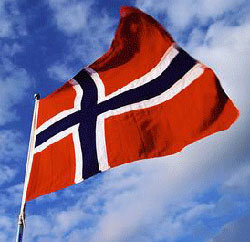 My mother is a little more practical, her wardrobe slightly more nautical even though she can no longer sail. In Norway her color schemes tend to mimic those of the Norwegian flag – blue, white and red. She fills pots, for example, with blue lobelia, red begonia and white impatiens, and places them all over the deck in front of the house and the terrace behind it. Inside there are more glorious red begonias in bright red china pots. When my father was alive they'd plant together. He liked to plant herbs too, for use during the summer – chives, parsley, dill (although dill is trickier to grow, more temperamental) and mint. It may have been easier when my father worked alongside her. With a companion one can stop for a beer or a little lunch or just to straighten up, sweep back one's hair and admire the handiwork. My father cut the lawn and trimmed the hedge, too, so no need for a nice Polish man to come in. He built a barbecue out of bricks on the rock and roasted fresh caught mackerel while my mother sat in her jeans and bikini top on the stoop at the back of the house where the cherry tree falls, peeling new potatoes and talking to him.
My mother is a little more practical, her wardrobe slightly more nautical even though she can no longer sail. In Norway her color schemes tend to mimic those of the Norwegian flag – blue, white and red. She fills pots, for example, with blue lobelia, red begonia and white impatiens, and places them all over the deck in front of the house and the terrace behind it. Inside there are more glorious red begonias in bright red china pots. When my father was alive they'd plant together. He liked to plant herbs too, for use during the summer – chives, parsley, dill (although dill is trickier to grow, more temperamental) and mint. It may have been easier when my father worked alongside her. With a companion one can stop for a beer or a little lunch or just to straighten up, sweep back one's hair and admire the handiwork. My father cut the lawn and trimmed the hedge, too, so no need for a nice Polish man to come in. He built a barbecue out of bricks on the rock and roasted fresh caught mackerel while my mother sat in her jeans and bikini top on the stoop at the back of the house where the cherry tree falls, peeling new potatoes and talking to him.
He wouldn't fish without her either, bringing her with him in the boat to steer and navigate while he threw out lines into the fjord. My mother is a good sport. She is happy to get up at 3am after a late night to fish the Black Rock, because my father told her that all the fish disappear when the sun starts to warm up the water. She is happy to drink beer at 7 in the morning because that's what the fisherman do. And she's a trendsetter too, bringing the Norfolk Slop (I don't know the history of these wonderful canvas-y seafaring tops but they're enormously useful and everyone in our family has one) from Blakeney to Tjøme as they served a practical purpose on early morning fishing expeditions.
We will arrive to cozy duvet-covered beds, pots of wildflowers, fluffy towels and some cold white wine. This is how my mother does things and I think this is how her mother did things too. I can't wait.
How to make a traditional Norwegian supper:
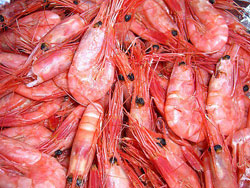 1 bag frozen Royal Greenland Shell-On Atlantic Prawns (available at Ikea)
1 bag frozen Royal Greenland Shell-On Atlantic Prawns (available at Ikea)
Hellman's (real) mayonnaise & sour cream mixed together in equal parts
Crusty french bread
Good quality butter
A nice bottle of white burgundy (or two)
De-frost the prawns about half an hour before you plan to serve them by laying them out on one layer on trays. When defrosted, pour them onto a large platter and set in the center of the dining room table.
Guests take a handful of prawns and shell their own. Prawns are eaten with fingers and dipped in mayonnaise. Bread and butter accompany.
To shell a prawn:
Hold prawn firmly in right hand.
Rip off head just below gills with left hand.
Unravel the center part with the legs (this should come off in one piece).
Hold the now naked prawn and pinch off its tail.
At the end of the meal, we throw the prawn shells into the sea for the crabs to eat.
Bumble Ward is a blogger and writer living in Los Angeles. She grew up with a Norwegian mother and an English father and spent every summer on an island in the Oslo fjord. www.misswhistle.com


